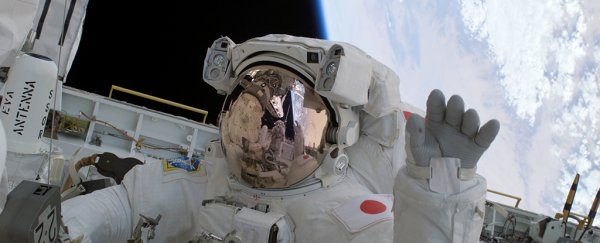There's still lots to explore and learn about the effects that space travel has on the body – and it seems those effects include some neuron rewiring that goes on in the brain.
Researchers studying the brains of 12 cosmonauts found what they describe as "significant microstructural changes" in the white matter that manages communications within the brain, and to and from the rest of the body.
The data were obtained through diffusion magnetic resonance imaging (dMRI) scans taken just before and right after the time participants spent in space, which lasted an average of 172 days. Further scans were carried out seven months later, and while there was a reversal of some changes, a few of them were still visible.
Specifically, the team found changes in neural tracts related to sensory and motor functions, and speculate this could have something to do with the cosmonauts' adaptation to life in microgravity.
"Considering the different physics and kinesthetics applying to the extreme environment of space and the hypothesis that these have significant effects on the brain's representation and control of the body, these tracts are therefore suspected to reflect this altered sensorimotor function shown in space travelers," the team writes.
This is the first time a brain imaging technique known as fiber tractography has been used in relation to the effects of spaceflight. The technique builds up a 3D picture of neuron tracts, revealing the brain's wiring scheme.
While changes in the brains of space travelers have been observed before, by using fiber tractography this study was able to take a better look at the actual connections between neurons and how they shifted.
Initially, the researchers thought that they'd spotted changes in the corpus callosum, the central highway connecting both hemispheres of the brain, but on closer analysis they were seeing an expansion of the brain's ventricles – a communicating network of chambers, filled with fluid, that sit next to the corpus callosum.
"The structural changes we initially found in the corpus callosum are actually caused by the dilation of the ventricles that induce anatomical shifts of the adjacent neural tissue," says neuroscientist Floris Wuyts, from the University of Antwerp in Belgium.
"Where initially it was thought that there are real structural changes in the brain, we only observe shape changes. This puts the findings in a different perspective."
Changes in the wiring of the brain aren't unusual of course – this plasticity enables us to learn new skills, make new memories, and so much more. At the moment it's not clear exactly what the implications of this space-related rewiring might be.
What's certain is that our bodies do try to adapt to the harsh environment of space. Previous studies have shown signs of an increased risk of disease and potential ways the brain could get damaged. It also appears that spending time in space affects men and women differently.
It's early days for the study of this particular brain adaptation using this particular scanning technique, but the more we know about human bodies and zero gravity, the better we'll be able to prepare for journeying to other worlds.
"These findings give us additional pieces of the entire puzzle," says Wuyts. "Since this research is so pioneering, we don't know how the whole puzzle will look yet. These results contribute to our overall understanding of what's going on in the brains of space travelers."
"It is crucial to maintain this line of research, looking for spaceflight induced brain changes from different perspectives and using different techniques."
The research has been published in Frontiers in Neural Circuits.
